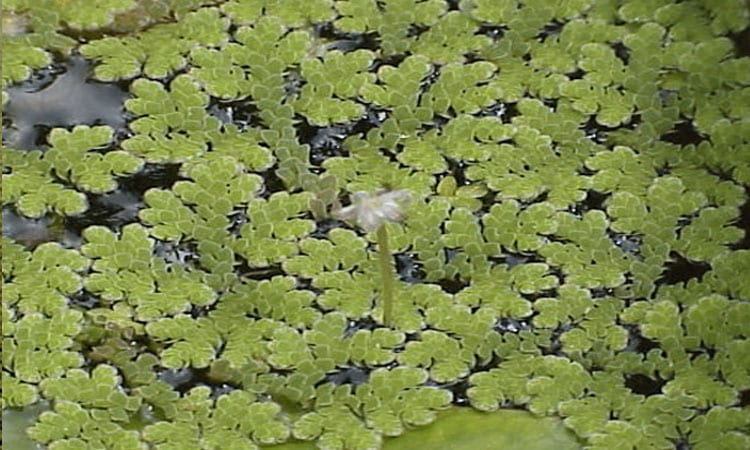Mosquito Fern is identified by tiny weeds with leaves that overlap tightly to create a scale-like, green quilted look on still or slow moving water
- English Name: Mosquito Fern
- Latin Name: Azolla spp.
- Life Cycle: Perennial
- Propogate: Reproduces through fragmentation
- States Affected: Common across the world including US, most prevalent in tropical regions
- Dangers: Mosquito Fern blocks sunlight from reaching submerged plants, affects boating and recreation
- Control Methods: Nets, Rakes, Removal tools, DeSkuzzer
Floating Small Invasive Lake Weed
The mosquito fern is a good looking weed. It is, as the name implies, a fern, which means it never flowers, but is still much valued as an ornamental plant. The reason being it is a small plant, typically about an inch or 2.5 cm wide with leaves that overlap tightly to create a scale-like, green quilted look. Why is it called a mosquito fern? Because those overlapping leaves cover the water surface so thoroughly, not even mosquitoes can find a way in to lay eggs. It is an anti-mosquito weed. But what is really remarkable about this weed is its super-fertilizer ability. At some point in the mist of history, farmers in Vietnam and most of Southeast Asia discovered that rice fields produced higher yields of rice if the mosquito fern was thrown in the mix. For centuries, rice farmers valued this weed as much as the rice, even storing it in containers between planting seasons. Scientists eventually figured out why. The Mosquito fern carries colonies of an interesting type of bacteria in the cavities of its leaves. The bacteria, cyanobacterium, takes nitrogen from the air and turns it into nitrate – exactly what fertilizer making factories spend millions to do. Because of this neat trick, the Mosquito Fern weed is arguably the most studied weed in the world as scientist try to figure out how to make cheap fertilizer.
Mosquito Fern Facts
The mosquito fern weed – scientific name the Azorra spp – is a free-floating plant whose roots are not anchored to the water bed. Its tiny, famously quilted leaves grow in alternating rows and have an upper lobe that is green and a lower lobe that is either transparent or white. Each plant has a single root which hangs in the water, drawing nutrients directly from the water. Sometimes, depending on seasons, the Mosquito fern may turn from bright green to a shade of red, which is why it is sometimes called “Red Azolla.” The weed prefers still or very slow-moving water, which means it is to be found in ponds, ditches, dams and lakes. It tends to grow in the same water with duckweed but even on its own, grows into huge floating mats of green over the surface of water. It is, of course, nicer looking than mats of duckweeds or other tiny water weeds because it looks more like a green carpet rather dirty algae. The Mosquito Fern reproduces through fragmentation. Parts of the parent weed break off to form new plants, which is partly why the weed forms such a compact mat. The weed is common in virtually all countries in the world but is most prevalent in tropical regions. It is to be found across the US.
Mosquito Fern Control
The Mosquito Fern clearly has a bright future. It is being extensively studied for its fertilizer making ability and it is widely grown in water gardens because of it ornamental value. It also makes good animal feed and can even be eaten by people. But the Mosquito Fern is also quite often a nuisance weed. Its tendency to grow into a dense mat totally colonizes a water body, denying other aquatic plants and animals adequate supply of oxygen and making it difficult to access or use the water. Fishing, transportation and recreation become impossible. The usual manner of taking care of excessive Mosquito Fern is to drag it out of the water using rakes or such other implements. The DeSkuzzer, is particularly effective in that task, because it has a long reach that allows one person to cover a wide area of the water from one position. The DeSkuzzer is a 5 foot wide floating seine with sturdy abrasion, ultra tough screen, and a 24 foot pull line. It is one of our weed control products.

